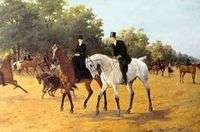Rotten Row
 Rotten Row from Hyde Park Corner. | |
| Former name(s) | Route du Roi |
|---|---|
| Length | 1,384 m (4,541 ft) |
| Location | Hyde Park, London, United Kingdom |
| Postal code | W2 |
| Nearest Tube station |
|
| East end | Hyde Park Corner |
| West end | Serpentine Road |
| Construction | |
| Completion | 1690 |
| Other | |
| Known for | Equestrianism |
Coordinates: 51°30′13.25″N 0°9′59″W / 51.5036806°N 0.16639°W



Rotten Row is a broad track running for 1,384 metres (4,541 ft)[1] along the south side of Hyde Park in London. It leads from Hyde Park Corner to Serpentine Road. During the 18th and 19th centuries, Rotten Row was a fashionable place for upper-class Londoners to be seen horse riding.[2] Today it is maintained as a place to ride horses in the centre of London, but it is little used. Rotten Row was established by William III at the end of the 17th century. Having moved court to Kensington Palace, William wanted a safer way to travel to St. James's Palace. He created the broad avenue through Hyde Park, lit with 300 oil lamps in 1690– the first artificially lit highway in Britain. The lighting was a precaution against highwaymen, who lurked in Hyde Park at the time.[3] The track was called Route du Roi, French for King's Road, which was eventually corrupted into "Rotten Row".[4]
In the 18th century, Rotten Row became a popular meeting place for upper-class Londoners. Particularly on weekend evenings and at midday, people dressed in their finest clothes to ride along the row and be seen.[2] The adjacent South Carriage Drive was used by society people in carriages for the same purpose.[2] In 1876, it was reconstructed as a horse-ride, with a brick base covered by sand.[1]
The sand-covered avenue of Rotten Row is maintained as a bridleway and forms part of Hyde Park's South Ride. It is convenient for the Household Cavalry, stabled nearby at Hyde Park Barracks in Knightsbridge, to exercise their horses. Members of the public may also ride, although few people have stables close enough to make use of it. Commercial stables nearby, the Hyde Park Stables and 'Ross Nye Stables, offer horse hire and riding lessons to the public.
Michael Crichton's 1979 feature film, The First Great Train Robbery, set in 1855 has a scene in which the character Edward Pierce (portrayed by Sean Connery) escorts Emily Trent (Pamela Salem) on a supposedly romantic ride along Rotten Row.[5]
A Royal plaque commemorating 300 years of Rotten Row was erected in 1990.
"ROTTEN ROW - The King's Old Road, Completed 1690This ride originally formed part of King William III's carriage drive from Whitehall to Kensington Palace. Its Construction was supervised by the Serveyor of their Majesties' Roads, Captain Michael Studholme and it was the first lamp-lit road in the Kingdom. Designated as a public bridleway in the 1730's, Rotten Row is one of the most famous urban riding grounds in the world."
Rotten Row is immortalised in a short piece of orchestral light music, composed by Wally Stott in 1958.
Other locations
"Rotten Row" is a location in at least 15 places in England and Scotland, such as in Lewes, East Sussex and Elie, Fife. It describes a place where there was once a row of tumbledown cottages infested with rats (raton) and dates to the 14th century or earlier, predating the London derivation.[6] Other historians have speculated the name might be a corruption of rotteran (to muster),[7] Ratten Row (roundabout way), or rotten (the soft material with which the road is covered).[8]
References
- 1 2 "Rotten Row". Pastscape. English Heritage. Retrieved 12 April 2011.
- 1 2 3 Dunton, Larkin (1896). The World and Its People. Silver, Burdett. pp. 30–31.
- ↑ Hibbert, Cristopher; Weinreb, Ben; Keay, John; Keay, Julia (2011). The London Encyclopaedia. Pan Macmillan. p. 424. ISBN 0230738788.
- ↑ "Hyde Park: History and Architecture". The Royal Parks. 2003-12-15. Retrieved 2009-01-14.
- ↑ The First Great Train Robbery. Dir. Michael Crichton. United Artists, 1979.
- ↑ Cameron, Kenneth (1959). The Place-Names of Derbyshire. Nottingham: English Place-Name Society. pp. 435, 449.
- ↑ Edward Walford. 'Hyde Park', Old and New London: Volume 4 (1878), pp. 375-405. Retrieved 29 January 2009.
- ↑ E Cobham Brewer. 'Dictionary of Phrase and Fable. Henry Altemus, 1898; Bartleby.com, 2000. Retrieved 29 January 2009.
External links
- The Fashionable Hour in Hyde Park—description of 18th century parading on Rotten Row.
- Poem by Frederick Lampson on Rotten Row.
- Hyde Park and Kensington Stables and Ross Nye Stables -possibly the only two remaining stables near Hyde Park.